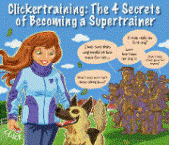Good Dog Training Advice
Get Fast & Simple Dog Training Tips to
Turn a Difficult Dog Into an Obedient Pet!
Identifying Your Dog's Temperament
There's something of a fallacy about dogs that goes around telling us all which breeds are calm, which ones are aggressive, and which ones are hyper. To be sure, some breeds may have more of a chance to become hyper or relaxed, but in general, every dog is
different. Why? Because, when you know your dog well enough and the fundamentals of dog psychology, you can cater your training methods more effectively to their personality. Types of Temperament To start with, know that not every dog will fit into just one category of temperament below. There are dozens of
different types of dogs with combinations of characteristics. Sedate, Relaxed Dogs - A sedate dog is one that will move at much lower speed and will
respond slowly to your commands. They will just generally take longer to teach much of anything. Energetic - Dogs with high energy levels are easy to excite and become distracted very
quickly. They will get wound up over pretty much anything and would much rather play with you than participate in
training of any kind. Strong Will - This is a stubborn dog and will be hard to train because they don't want to be trained and are often intelligent enough to recognize the boundaries they can push. You'll need to be incredibly patient and firm with them. You should avoid anything that makes it into a challenge, however. You'll recognize a strong willed dog in that they will not become aggressive in their training, but will frequently ignore your commands, turning their back to you or backing up from you when you offer a command. Shy Dogs - A shy dog is going to be very susceptible to fear and needs to be handled carefully. Avoid quick movements, harsh tones or loud voices or you will only frighten the dog. Never use leash corrections and keep your voice soft and quiet at all times to soothe the dog. Shy dogs will usually be shaky and easily frightened. Small dogs fit the bill more often than not, but large
dogs can be just as shy, especially if they had any traumatic experiences as a puppy. Effective Training Once you've pinpointed exactly what type of temperament your dog has, you can jump into the training process in
earnest. You'll need to be patient and spend time learning what works and what doesn't.
Do that and you'll be well on your way to a happy, obedient and healthy dog.
| |
|


Discover the Secrets to Training Your Dog Or Puppy. Huge BONUSES for a limited time only!
Click here now...
|
http://GoodDogTrainingAdvice.com






